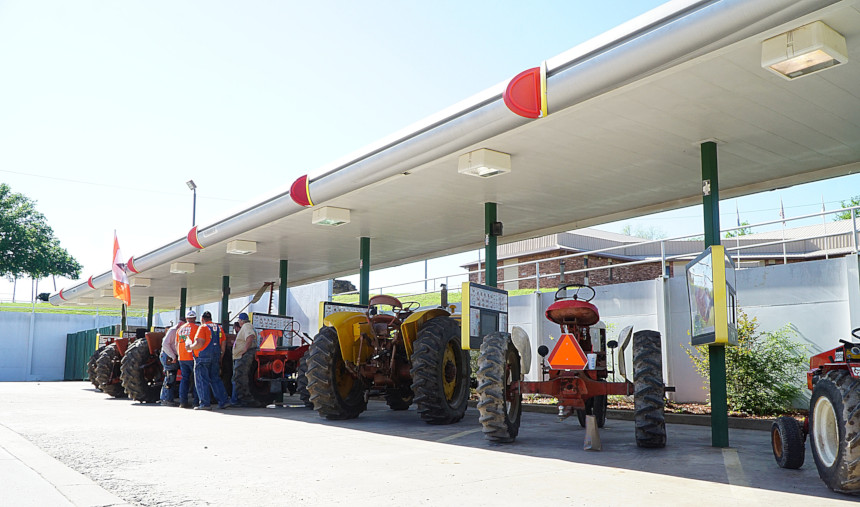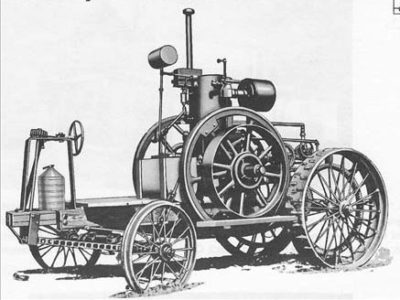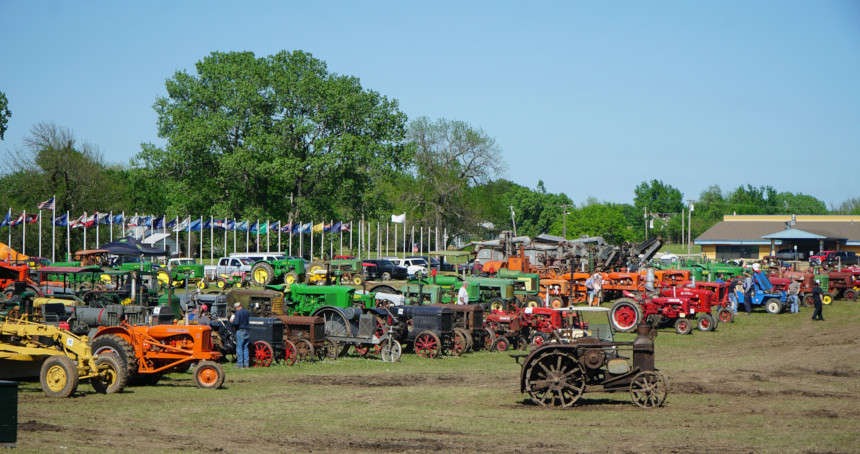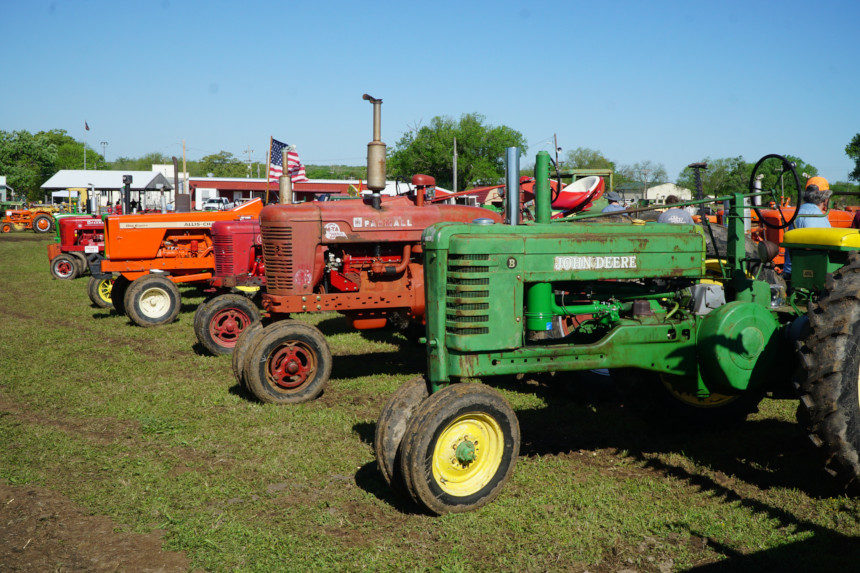Dirty motor oil shot out of the spark plug cylinders of the Farmall A, flying across the workshop and splattering on the floor as the old tractor’s engine turned over for the first time in years. This was the scene tractor enthusiast Brett Geary created a few years ago in his mother’s wood-working building In Pawnee, Oklahoma, after months of laboring to get his uncle’s tractor running again.
It was Geary’s first foray into the world of vintage farm machinery. Now 18 years old, he still remembers the rush of emotions he felt when the engine sputtered and whirred to life. “The first time it fired off, you should have seen the smile on my face,” Geary said. “There’s nothing like the sound of one of those things, when they’ve sat for years, and then it just pops off.”
When the spark plugs lit the gas inside the tractor’s cylinders, something else sparked, too. Geary’s passion for vintage farm machinery was ignited — and it’s been burning brighter and brighter ever since. He’s just one young farm tractor collector to have such an experience. Spurred on by the desire to preserve family memories or the urge to turn a wrench, tractor aficionados decades younger than the equipment they own have found joy and purpose in buying old tractors, fixing them up, and showing them off.
Much like classic car enthusiasts gather at hot-rod shows in the summer, tractor collectors have get-togethers of their own across the United States. Geary’s hometown of Pawnee is home to the annual Oklahoma Steam Threshers & Gas Engine Association’s tractor show, one of the largest in Oklahoma and the region. Countless collectors bring their decades-old rigs to town in early May for parades, tractor-themed games and shows — and even a trip to the local Sonic Drive-In for ice cream.

There’s not much official data about tractor-collecting, its participants, or their ages. But if you aim to keep your finger on the pulse of the hobby, go to a tractor show and look around. It’s likely you’ll find that tractor collecting is firing on all cylinders, especially with young people.
Tractors’ Roots
Agricultural tractors began with primitive steam-powered machines in the 19th century, when large engines, not too dissimilar from steam locomotives, powered threshing machines in wheat fields. Much of the harvesting and threshing work was still done by hand; the tractors mainly turned belts that churned grain through threshers.
The first gasoline-powered tractor was invented in 1892 by John Froelich, a farmer in northeast Iowa. From there, other tractor manufacturers took off with the idea, creating dozens of different models with specialty implements and applications.

Through much of the 20th century, tractor makers like International Harvester, Allis-Chalmers, Case, and others rose to prominence alongside standard-bearers like John Deere. As time went on, tractors got bigger. By the 1970s, ’80s and ’90s, consolidation in the tractor-manufacturing industry — and the demand for more horsepower in the fields — meant many of the tractors of bygone days were too small for most farming operations.
But while newer tractors took to the fields, older tractors were still around. The folks who started the Pawnee tractor show 55 years ago set out with a mission to keep older steam tractors alive. Today, some of the tractors built around the time of the first show are already being put on display, with equipment from the 1920s through the 1970s being most common.
Many of the later-model tractors’ original owners and operators are still around, and younger folks want to hear their stories.

That’s one reason new collectors are finding passion for the hobby. Jim Denney, who grew up on his family’s farming operation near Newkirk, Oklahoma, was raised around vintage farm tractors. His collection of 1960s-era Case tractors is his “pride and joy.” He keeps the engines in working order, and he enjoys taking them to shows.
Part of the 24-year-old’s motivation for keeping old tractors operational is to show people how farming practices have evolved. Modern tractors have enclosed cabs, air conditioning, and speaker systems; his vintage tractors offer the driver a prime seat in the open air and sunshine. The only music you’ll hear is the rumbling of the exhaust. And while Denney is a mechanic by trade, he’s a storyteller by heart: “I like preserving the story, not just the tractor.”
Not Just for Looks
Tractor shows aren’t the only places where tractor-loving youth are riding their rigs. High schools across the South and Midwest have hosted so-called “tractor days,” where students drive their equipment to school. The events often take place in conjunction with National Future Farmers of America Week, commemorating the longstanding extracurricular organization, in late February each year.
Some students are discovering that old farm tractors are prime candidates for class projects. The Pennsylvania State Fair hosts an antique tractor restoration competition each year for state FFA students who’ve resurrected old equipment, giving students a chance to show off their work and win award money. Kacie Hulshof, former associate editor of AGDAILY, wrote about the contest in January: “The FFA members had to do more than just restore an antique tractor. First when acquiring the tractor, they are encouraged to find out the history of the antique tractor including where it came from. Sometimes these tractors can be in families for generations, or it sits in a field until it is needed once again. While on their journey to restore the tractor, FFA members are encouraged to document the process with videos.”
Not all schools are receptive of students’ tractor-loving antics, however. In early May, police in Norwich, New York, impounded a vintage farm tractor a student drove to school, according to WBNG 12 News. However, the incident proved to be a public relations debacle for the school district; in the following days, other students and community members drove their tractors to the school to protest the actions of the school and the police.
‘Fun Memories’
Some collectors say they got into the hobby to keep old tractors — and their owners’ stories — alive. Others have a similar goal: to help other people make memories of their own. Though a veteran collector himself, Winfield, Kansas, farmer and mechanic Roger Schmidt hopes to teach young collectors that old equipment is worth working on — and worth taking pride in.
For several years, local youth have sought him out to learn how to drive and work on tractors. He has let them drive his tractors in local parades, climb aboard for rides during tractor shows, and help turn a wrench when a lug nut needs tightening.
Schmidt, soon to be 68 years old, was about 12 when he learned a lesson from his grandfather about keeping old machinery. While working on his grandfather’s truck, Schmidt suggested that his grandfather buy a new truck. His grandfather told him that anyone can buy a new truck, but not everyone can keep an old one running. He’s never forgotten that lesson. In his teenage years, working long hours tilling soil and planting crops in his family’s fields, Schmidt saw tractors as a means to an end: bringing another crop in to harvest and putting another one in the ground.
Today, as a member of the K&O Steam & Gas Engine Club, he sees that same machinery as a tool for young people to learn valuable mechanical skills — and some life lessons, like enjoying the outdoors and cultivating responsibility. With roughly 60 tractors in his collection, he’s got ample opportunity for aspiring tractor collectors to have fun.
“I just accepted it years ago that God was sending them to me,” Schmidt said of his protégés. “I like seeing kids have fun. I look back on my life, and when my friends were going to church camp and 4H camp, I was out on a tractor working. I missed a lot of things in life, and you know what? I’m having fun with the kids right now.”
He’s got another goal: to make his “students” smarter than he is. Maintaining farm tractors can include skills like financial management and metal-painting. And it includes having some tales to tell.
“I’ve got some wonderful stories about my life, and I want these kids to have good stories to tell about their lives. Some of the kids I know don’t have anything good in life happen to them, and I want them to have something fun in their life to talk about.”
Young collectors like Geary say they’re thankful for the help of longtime operators, whose advice is sage — especially when equipment breaks down.
So, how does a young collector’s joy translate to other young people who may be more preoccupied with video games and computers?
“If I’m talking to somebody that doesn’t entirely have the joy that I have for it, I’ll be like, ‘Look. You’ve seen pictures, you’ve seen what I have,’” Geary said. “’There’s just no true way to explain the happiness and joy it brings when you’re running one.’”
While the number of young tractor collectors may not be large yet, those who are already invested in the hobby say their passion continues to grow. They’ll keep sharing their love of tractors with people who stop by to look at the farm machinery of the past during tractor shows. At least for now, old farm tractors are finding new homes.
Featured image: Vintage tractors are lined up on display at the Oklahoma Steam Threshers & Gas Engine Association’s 55th annual tractor show in Pawnee, Oklahoma, on May 7. (Photo courtesy of Jordan Green)
Become a Saturday Evening Post member and enjoy unlimited access. Subscribe now




Comments
I pray that this email note finds all of our Tractor club friends healthy and in good spirits across America.
I am the secretary for the Northwest Vintage Iron Tractor club. Our annual Tractor club field show brought allot of smiling faces to the show.
Take a look at our Facebook page. Fall City Washington is in the Agricultural production zone of King County. Our farming company depends on tractors that run and the safety program for our employees.
We hope to begin bring in FFA student’s and 4H kids and volunteers into our club to begin building a safety driving program for families who are new to family farming areas. Washington State is rich with active FFA and 4H club’s.
It’s always good to review safety!!. ️
Our club is tied to the LeMay Car museum in Tacoma Washington. Just off of I-5. Art LeMay was my husband’s art teacher in Jr high school 50 years ago. He nows how to paint!!
Stay safe and remember!! Safety Safety Safety!!
Blessings to you all⚡️.
Celia Smallidge Wheeler
Chairwoman of the Board
Oak Hills Vegetable Farms Inc
Oak Hills Inc
Since 1952
Walla Walla onion’s Washington State Official Vegetable
Kandy Sweet Corn and Rhubarb
Agricultural Research
Northwest Vintage Iron Tractor club is located in the Agricultural production zone of Fall City Washington. The tractor club also enjoys the old cars and trucks, too.
“Make Farming Great Again!!”.
Stay safe!
Martin Lee Wheeler
President
Oak Hills Vegetable Farms Inc
Walla Walla onion’s Washington State Official Vegetable
I marked them and told you my name something got messed up.
What is sad is I am older than those tractors accept the cleat wheel in front, but I do remember driving one and why farmers went to rubber tires, on a hard dirt surface getting to the field they would beat you to death and in the field for a 12 to 14 hour day was not pleasant ( I did not work in the field with one but I did get to drive one at Vista California in a parking lot.
I remember a monster thrashing machine in a building to house that machine near Plentywood Montana I think it was about as long and high as a semi trailer. Several farmers used that one machine to do all there harvest, I don’t know if it was steam or gasoline but I know that when it fired we all kind of bounced off the ground.
I remember a tractor at the Fowler residence in Plentywood , they were using the fly wheel to run a saw mill (I think) it was about twice the size of the tractor in the photo above. I also remember getting my water truck breaking though the grass sod on top of a lake and several wenches trying to pull me out to no avail. Finally and old farmer said I will get my tractor, it took about an hour for him to get bacck to wgere we were all waiting. We watched as he slowly pulled up about 50mfeet behind my truck ( it took three of us to lift the chain and hook it to truck.
We all kind of chuckled and joked about that beat up old two piston tractor being able to pull the chain up tight it took awhile , but the engine tightened the chain and did not change the engine RPM at all, it then started pulling the trunk out of a hole that was near the top of the wheels in that old cleat track did not miss a stroke or even change the RPM. IT was slow we joked about making a mark in the grass to see if it was moving. Finally the truck was back on solid ground.
I learned a few valuable lessons that day. When my Grandpa and those Farmers of the old days spoke, you had better listen.